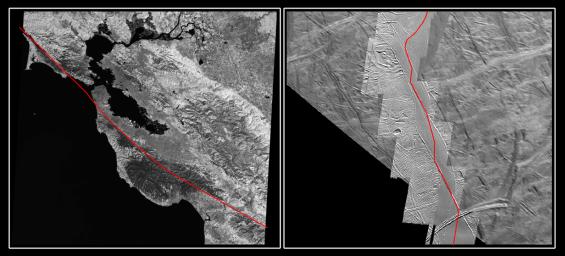
|
The San Andreas Fault and a Strike-slip Fault on Europa
- Click the image above for a larger view
- Full-Res JPEG (1231 x 558) (134.7 kB)
- Full-Res TIFF (1231 x 558) (504.9 kB)
Caption:
The mosaic on the right of the south polar region of Jupiter's moon Europa shows the northern 290 kilometers (180 miles) of a strike-slip fault named Astypalaea Linea. The entire fault is about 810 kilometers (500 miles) long, the size of the California portion of the San Andreas fault on Earth which runs from the California-Mexico border north to the San Francisco Bay.
The left mosaic shows the portion of the San Andreas fault near California's san Francisco Bay that has been scaled to the same size and resolution as the Europa image. Each covers an area approximately 170 by 193 kilometers(105 by 120 miles). The red line marks the once active central crack of the Europan fault (right) and the line of the San Andreas fault (left).
A strike-slip fault is one in which two crustal blocks move horizontally past one another, similar to two opposing lanes of traffic. The overall motion along the Europan fault seems to have followed a continuous narrow crack along the entire length of the feature, with a path resembling stepson a staircase crossing zones which have been pulled apart. The images show that about 50 kilometers (30 miles) of displacement have taken place along the fault. Opposite sides of the fault can be reconstructed like a puzzle, matching the shape of the sides as well as older individual cracks and ridges that had been broken by its movements.
Bends in the Europan fault have allowed the surface to be pulled apart. This pulling-apart along the fault's bends created openings through which warmer, softer ice from below Europa's brittle ice shell surface, or frozen water from a possible subsurface ocean, could reach the surface. This upwelling of material formed large areas of new ice within the boundaries of the original fault. A similar pulling apart phenomenon can be observed in the geological trough surrounding California's Salton Sea, and in Death Valley and the Dead Sea. In those cases, the pulled apart regions can include upwelled materials, but may be filled in mostly by sedimentary and erosional material deposited from above. Comparisons between faults on Europa and Earth may generate ideas useful in the study of terrestrial faulting.
One theory is that fault motion on Europa is induced by the pull of variable daily tides generated by Jupiter's gravitational tug on Europa. The tidal tension opens the fault; subsequent tidal stress causes it to move lengthwise in one direction. Then the tidal forces close the fault up again. This prevents the area from moving back to its original position. If it moves forward with the next daily tidal cycle, the result is a steady accumulation of these lengthwise offset motions.
Unlike Europa, here on Earth, large strike-slip faults such as the San Andreas are set in motion not by tidal pull, but by plate tectonic forces from the planet's mantle.
North is to the top of the picture. The Earth picture (left) shows a LandSat Thematic Mapper image acquired in the infrared (1.55 to 1.75 micrometers) by LandSat5 on Friday, October 20th 1989 at 10:21 am. The original resolution was 28.5 meters per picture element.
The Europa picture (right) is centered at 66 degrees south latitude and 195 degrees west longitude. The highest resolution frames, obtained at 40 meters per picture element with a spacecraft range of less than 4200 kilometers (2600 miles), are set in the context of lower resolution regional frames obtained at 200 meters per picture element and a range of 22,000 kilometers (13,600 miles). The images were taken on September 26, 1998 by the Solid State Imaging (SSI) system on NASA's Galileo spacecraft.
Background Info:
The Jet Propulsion Laboratory, Pasadena, CA manages the Galileo mission for NASA's Office of Space Science, Washington, DC.
This image and other images and data received from Galileo are posted on the World Wide Web, on the Galileo mission home page at http://galileo.jpl.nasa.gov . Background information and educational context for the images can be found at http://www.jpl.nasa.gov/galileo/sepo .
Cataloging Keywords:
| Name | Value | Additional Values |
|---|---|---|
| Target | Europa | |
| System | Jupiter | |
| Target Type | Satellite | |
| Mission | Galileo | |
| Instrument Host | Galileo Orbiter | |
| Host Type | Orbiter | |
| Instrument | Solid-State Imaging (SSI) | |
| Detector | ||
| Extra Keywords | Color, Infrared, Water | |
| Acquisition Date | ||
| Release Date | 1998-12-07 | |
| Date in Caption | 1998-09-26 | |
| Image Credit | NASA/JPL/ASU | |
| Source | photojournal.jpl.nasa.gov/catalog/PIA01645 | |
| Identifier | PIA01645 | |
